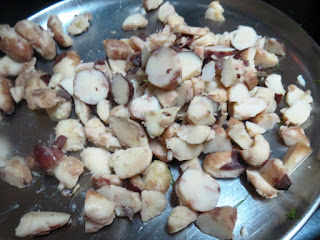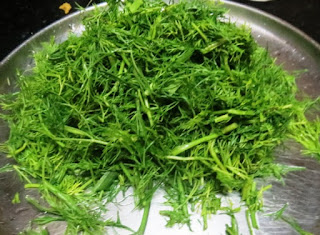Dil leaves & Jack Seeds Curry is a gravy dish. I had some jack seeds at home and wanted to use it in cooking. They are good with southe kai curry (Mangalore cucumber). But as usual I wanted some change. I used Dil leaves which are the healthiest leaves and they are good remedy for gas too. There is a belief that jack seeds makes gas (vayu, or vaatha). People do avoid eating these seeds. But jack fruit seeds are loaded with good healthy nutrients.
Lets see some benefits of having jack seeds in our diet.
Jackfruits seeds are very rich in digestible starch, protein and minerals. It is rich source of carbohydrates. They are rich in dietary fiber. They contain Vitami A, C and B Vitamins. They also contain minerals like calcium, zinc and phosphorus. They contain anti-ageing , anti ulcer and good amount of antioxidant properties.
Dil Leaves & Jack Seeds Curry has no onion or garlic and can be eaten with chapatis, rotis, dosas, idli, poori and plain rice.
Lets see the recipe now.
Jackfruit seeds : 1 Bowl (Cooked)
Toor /Moong dal : 1/2 Cup
Methi/ Fenugrik seeds : 1/2 Teaspoon
Rasam Power : 2 Teaspoons
Turmeric Powder : a little
Coconut : 2 to 3 Tablespoons
Pepper pods : 4 to 5
Lemon : 1/2 of 1 lemon extract
Salt : To taste
Oil : 1 Teaspoon
Mustard seeds : 1/2 Teaspoon
Jeera/Cumin seeds : 1/2 Teaspoon
Curry leaves : 6 to 8
Coriander leaves : 2 Tablespoons
Ingh/Asafoetida : A pinch
2. Wash and pressure cook toor dal
3. Wash and cut dil leaves into small and keep it aside.
4. Grate coconut and crush pepper pods and keep it aside.
5. Grind coconut and pepper pods with little water and remove from the mixi jar. Keep it aside.
6. Keep a pan on the fire and heat. Put mustard seeds and jeera. Let it splutter. Add crushed pepper.
7. Add ingh, curry leaves and cut dil leaves. Fry them nicely on slow flame for 2 minutes. Add little water and let it cook till soft.
8. Add cooked jackfruit, toor dal and mix it well.
9. Add required salt and boil for a minute. Stir in between. Add rasam powder, methi seeds (raw) and ground coconut.
10. Mix it well and Let it boil for another 2 to 3 minutes. ( Add water if required ).
11. Put off the fire. Add lemon extract and mix it well and shift the curry to a serving dish.
12. Serve with the main dish you have prepared.
You can sundry the jackfruit seeds and remove the outer hard skin. (This way it will be easy). You must cook the seeds till soft. (at least 8 to 10 minutes). I have used home made rasam powder. Using garam masala powder, any brand sambar powder is optional. You can also use green chilly to add the spicy taste to the curry. Adding ground coconut is also optional. It adds taste to the curry. You can use any other vegetables like carrots, beans and potato are optional. Adding onions and garlic is optional.( I have not added ). You can use any type of dal. Toor, moong or masoor dals (Optional). You can use rajma , channa or any other bean instead of jack seeds.
Time : 30 minutes.
Serves : 4
Lets see some benefits of having jack seeds in our diet.
Jackfruits seeds are very rich in digestible starch, protein and minerals. It is rich source of carbohydrates. They are rich in dietary fiber. They contain Vitami A, C and B Vitamins. They also contain minerals like calcium, zinc and phosphorus. They contain anti-ageing , anti ulcer and good amount of antioxidant properties.
Dil Leaves & Jack Seeds Curry has no onion or garlic and can be eaten with chapatis, rotis, dosas, idli, poori and plain rice.
Lets see the recipe now.
Ingredients :
Dil leaves : 1 Bundle (Medium size)Jackfruit seeds : 1 Bowl (Cooked)
Toor /Moong dal : 1/2 Cup
Methi/ Fenugrik seeds : 1/2 Teaspoon
Rasam Power : 2 Teaspoons
Turmeric Powder : a little
Coconut : 2 to 3 Tablespoons
Pepper pods : 4 to 5
Lemon : 1/2 of 1 lemon extract
Salt : To taste
Oil : 1 Teaspoon
Mustard seeds : 1/2 Teaspoon
Jeera/Cumin seeds : 1/2 Teaspoon
Curry leaves : 6 to 8
Coriander leaves : 2 Tablespoons
Ingh/Asafoetida : A pinch
Method :
1. Wash, remove the outer skin of jackfruit seeds, cut and cook in a pressure cooker.2. Wash and pressure cook toor dal
3. Wash and cut dil leaves into small and keep it aside.
4. Grate coconut and crush pepper pods and keep it aside.
5. Grind coconut and pepper pods with little water and remove from the mixi jar. Keep it aside.
6. Keep a pan on the fire and heat. Put mustard seeds and jeera. Let it splutter. Add crushed pepper.
7. Add ingh, curry leaves and cut dil leaves. Fry them nicely on slow flame for 2 minutes. Add little water and let it cook till soft.
8. Add cooked jackfruit, toor dal and mix it well.
9. Add required salt and boil for a minute. Stir in between. Add rasam powder, methi seeds (raw) and ground coconut.
10. Mix it well and Let it boil for another 2 to 3 minutes. ( Add water if required ).
11. Put off the fire. Add lemon extract and mix it well and shift the curry to a serving dish.
12. Serve with the main dish you have prepared.
Note :
Time : 30 minutes.
Serves : 4


























